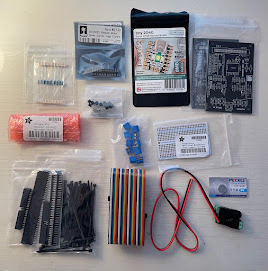I'm back again for more telescope fun! This is Part 2 of my second telescope building session, where I learn how to solder :) For this telescope, we'll need to solder pins on multiple controllers and eventually build our own circuit board to drive the telescope. Soldering ain't easy, so come along for the ride as I deal with molten metal – the ups and the downs.
Learning how it works
Before I could solder anything into the actual technology for the telescope, I first needed to learn how to deal with the soldering equipment safely. Dr. Proffen shipped me a practice board and some pin headers to learn the basics on. If you don't know, pin headers allow us to stick electronics together to make connections and run our technology. They're very important, but most of the time, we need to solder them onto our parts ourselves (don't ask me why).
Soldering is deceivingly uncomplicated in my opinion. The tricky part is staying safe and finding the right amount of metal and heat to get the perfect joint. The equipment needed for soldering is:
- soldering iron
- soldering iron stand
- cleaning sponge
- solder (melting metal)
- pin headers
- items to solder
For all of my soldering, I used the iron on 350°. That's really hot, so it's important to remember to always keep the iron in its stand when you're not actively using it. A damp sponge, which came with the kit I bought, is used for cleaning the tip of the iron of solder.
Once my soldering iron was to temperature, it was time to solder! When I was learning, I put about 10 pin headers into my practice board and attached it to a breadboard. Now comes the part that is both easy and difficult. The instructions are simple: heat the exposed pin with the soldering iron, feed a bit of solder into the pin, let it melt into a perfect shiny pool, and release. However, getting the timing right to properly melt the solder was quite difficult. I also needed to make sure I used just enough solder so that the connection was secure without making a mound of metal over the pins. Each pin must have its own separate mountain of solder; if any of the pins are connected, the circuit board could potentially be fried.
Stepper motor drivers and the tiny2040
Once I got the hang of soldering, it was time to do the real stuff. For the telescope, we're building a custom circuit board full of technology to drive the 2 stepper motors. These motors are what will turn the telescope (see
Telescope Session 2 - Building the base for more info), and they are powered by 2 drivers. In addition, we need a device called the tiny2040, which will work with the Raspberry Pi to run the telescope as a whole.
All three of these components need pin headers attached to them, so I had a lot of work to do. It wasn't without its challenges either! The first side of the first driver went beautifully, but on the second side... the metal didn't melt properly and started to stick to the components of the driver. Dr. Proffen and I problem-solved though, and after many painstaking attempts to clean up the problematic metal, the driver was complete. One more driver and a tiny2040 later, and I was about 1/3 done with all the telescope soldering!
Building the circuit board
The final soldering task for this telescope is by far the most complicated: building the custom circuit board. Dr. Proffen and I had to attach a multitude of pieces to a blank board to cover everything the telescope would need; there were 24 different parts in total! Here's what we used:
- 1 10K Ohm resistor
- 1 680 Ohm resistor
- 3 47uF capacitors
- 1 transistor
- 5 blue terminal blocks
- 2 stepper motor drivers (+ heatsinks)
- tiny2040
- pin headers
- 40way PCB header
- 40way rainbow ribbon cable
That's... quite a lot of pieces, so let's break it down as past me solders them all onto the circuit board. Starting with the resistors: they decrease the voltage of electrical currents so that certain parts don't get fried from too much power. The capacitors act like a reserve battery, but much faster. If there were a sudden power surge, the capacitors would hopefully keep everything from going crazy. Since the tiny2040 doesn't have an on/off switch, we use the transistor to tell it when to have the power on. The blue terminal blocks allow us to make connections between the stepper motor drivers and the rest of the telescope. We could connect directly to the drivers, but in the case of a faulty piece, this is a much easier setup.
We need our 2 stepper motor drivers from before; we added heatsinks on to make sure they don't overheat. Our tiny2040 also gets added, along with some pin headers for a GPS component. Finally, we soldered on a 40-way set of pin headers, which took forever!! Once this was on, we could connect our absolutely beautiful rainbow ribbon cable from these headers to our Raspberry Pi.
Wrapping up
Phew, we did it! Soldering was a new but super fun experience. I love doing hands-on electronics work, so I had a great time. Building a circuit board is something to be incredibly proud of; it's probably the most complex STEM thing I've ever done! Keep an eye out for the final blogpost of Session 2–preparing the Raspberry Pi. Thanks for reading!












